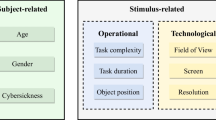Abstract
In this paper, we investigate how changes in the saliency of the Virtual Environment (VE) affect our visual attention during different tasks. We investigate if users are attracted to the most salient regions in the VE. This knowledge will help researchers design optimal VR environments, purposefully direct the attention of users, and avoid unintentional distractions. We conducted a user study (N = 30) where participants performed tasks (video watching, object stacking, visual search, waiting) with two different saliency conditions in the virtual environment. Our findings suggest that while participants notice the differences in saliency, their visual attention is not diverted towards the salient regions when they are performing tasks.
Access this chapter
Tax calculation will be finalised at checkout
Purchases are for personal use only
Similar content being viewed by others
References
Albayrak, D., Askin, M.B., Capin, T.K., Celikcan, U.: Visual saliency prediction in dynamic virtual reality environments experienced with head-mounted displays: an exploratory study. In: 2019 International Conference on Cyberworlds (CW), pp. 61–68 (2019)
Bailey, R., McNamara, A., Sudarsanam, N., Grimm, C.: Subtle gaze direction. ACM Trans. Graph. 28(4), 14 (2009), Article 100. https://doi.org/10.1145/1559755.1559757
Boletsis, C.: The new era of virtual reality locomotion: a systematic literature review of techniques and a proposed typology. Multimodal Technol. Interact. 1(4), 24 (2017)
De Abreu, A., Ozcinar, C., Smolic, A.: Look around you: saliency maps for omnidirectional images in VR applications. In: 2017 Ninth International Conference on Quality of Multimedia Experience (QoMEX), pp. 1–6 (2017)
Diemer, J., Alpers, G.W., Peperkorn, H.M., Shiban, Y., Mühlberger, A.: The impact of perception and presence on emotional reactions: a review of research in virtual reality. Front. Psychol. 6(2015), 26 (2015)
Fang, Y., Wang, J., Narwaria, M., Le Callet, P., Lin, W.: Saliency detection for stereoscopic images. IEEE Trans. Image Process. 23(6), 2625–2636 (2014)
Gorecky, D., Khamis, M., Mura, K.: Introduction and establishment of virtual training in the factory of the future. Int. J. Comput. Integr. Manuf. 30(1), 182–190 (2017). https://doi.org/10.1080/0951192X.2015.1067918
Itti, L., Koch, C.: A saliency-based search mechanism for overt and covert shifts of visual attention. Vis. Res. 40(10–12), 1489–1506 (2000)
Judd, T., Ehinger, K., Durand, F., Torralba, A.: Learning to predict where humans look. In: 2009 IEEE 12th International Conference on Computer Vision, pp. 2106–2113 (2009)
Koehler, K., Guo, F., Zhang, S., Eckstein, M.P.: What do saliency models predict? J. Vis. 14(3), 14 (2014)
Le Meur, O., Ninassi, A., Le Callet, P., Barba, D.: Overt visual attention for free-viewing and quality assessment tasks: impact of the regions of interest on a video quality metric. Sig. Process. Image Commun. 25(7), 547–558 (2010)
Logan, G.D., Gordon, R.D.: Executive control of visual attention in dual-task situations. Psychol. Rev. 108(2), 393 (2001)
Maggioni, C.: A novel gestural input device for virtual reality. In: Proceedings of IEEE Virtual Reality Annual International Symposium, pp. 118–124. IEEE (1993)
Mäkelä, V., et al.: Virtual field studies: conducting studies on public displays in virtual reality. In: Proceedings of the 2020 CHI Conference on Human Factors in Computing Systems (CHI 2020), New York, NY, USA, pp. 1–15. Association for Computing Machinery (2020). https://doi.org/10.1145/3313831.3376796
Moussaïd, M., et al.: Crowd behaviour during high-stress evacuations in an immersive virtual environment. J. R. Soc. Interface 13(122), 20160414 (2016)
Ordaz, N., Romero, D., Gorecky, D., Siller, H.R.: Serious games and virtual simulator for automotive manufacturing education & training. Procedia Comput. Sci. 75(2015), 267–274 (2015)
Oyekoya, O., Steptoe, W., Steed, A.: A saliency-based method of simulating visual attention in virtual scenes. In: Proceedings of the 16th ACM Symposium on Virtual Reality Software and Technology, pp. 199–206 (2009)
Regian, J.W., Shebilske, W.L., Monk, J.M.: Virtual reality: an instructional medium for visual-spatial tasks. J. Commun. 42, 136–149 (1992)
Rivu, R., et al.: Remote VR studies - a framework for running virtual reality studies remotely via participant-owned HMDs. CoRR abs/2102.11207 (2021)
Rothe, S., Hußmann, H.: Guiding the viewer in cinematic virtual reality by diegetic cues. In: De Paolis, L.T., Bourdot, P. (eds.) AVR 2018. LNCS, vol. 10850, pp. 101–117. Springer, Cham (2018). https://doi.org/10.1007/978-3-319-95270-3_7
Steed, A., Pan, Y., Zisch, F., Steptoe, W.: The impact of a self-avatar on cognitive load in immersive virtual reality. In: 2016 IEEE Virtual Reality (VR), pp. 67–76. IEEE (2016)
Sun, Y., Fisher, R.: Object-based visual attention for computer vision. Artif. Intell. 146(1), 77–123 (2003)
Sung, M., Choi, S.: Selective anti-aliasing for virtual reality based on saliency map. In: 2017 International Symposium on Ubiquitous Virtual Reality (ISUVR), pp. 16–19 (2017)
Underwood, G., Foulsham, T., van Loon, E., Underwood, J.: Visual attention, visual saliency, and eye movements during the inspection of natural scenes. In: Mira, J., Álvarez, J.R. (eds.) IWINAC 2005. LNCS, vol. 3562, pp. 459–468. Springer, Heidelberg (2005). https://doi.org/10.1007/11499305_47
Veas, E.E., Mendez, E., Feiner, S.K., Schmalstieg, D.: Directing attention and influencing memory with visual saliency modulation. In: Proceedings of the SIGCHI Conference on Human Factors in Computing Systems (CHI 2011), New York, NY, USA, pp. 1471–1480. Association for Computing Machinery (2011). https://doi.org/10.1145/1978942.1979158
Vig, E., Dorr, M., Barth, E.: Learned saliency transformations for gaze guidance. In: Human Vision and Electronic Imaging XVI, vol. 7865, p. 78650W. International Society for Optics and Photonics (2011)
Vinson, N.G.: Design guidelines for landmarks to support navigation in virtual environments. In: Proceedings of the SIGCHI conference on Human Factors in Computing Systems, pp. 278–285 (1999)
Walther, D., Koch, C.: Modeling attention to salient proto-objects. Neural Netw. 19(9), 1395–1407 (2006)
Zhang, F.J., Dai, G.Z., Peng, X.: A survey on human-computer interaction in virtual reality. Sci. Sin. Inform. 46(12), 1711–1736 (2016)
Author information
Authors and Affiliations
Corresponding author
Editor information
Editors and Affiliations
Rights and permissions
Copyright information
© 2021 IFIP International Federation for Information Processing
About this paper
Cite this paper
Rivu, R., Mäkelä, V., Hassib, M., Abdelrahman, Y., Alt, F. (2021). Exploring How Saliency Affects Attention in Virtual Reality. In: Ardito, C., et al. Human-Computer Interaction – INTERACT 2021. INTERACT 2021. Lecture Notes in Computer Science(), vol 12936. Springer, Cham. https://doi.org/10.1007/978-3-030-85607-6_10
Download citation
DOI: https://doi.org/10.1007/978-3-030-85607-6_10
Published:
Publisher Name: Springer, Cham
Print ISBN: 978-3-030-85606-9
Online ISBN: 978-3-030-85607-6
eBook Packages: Computer ScienceComputer Science (R0)





